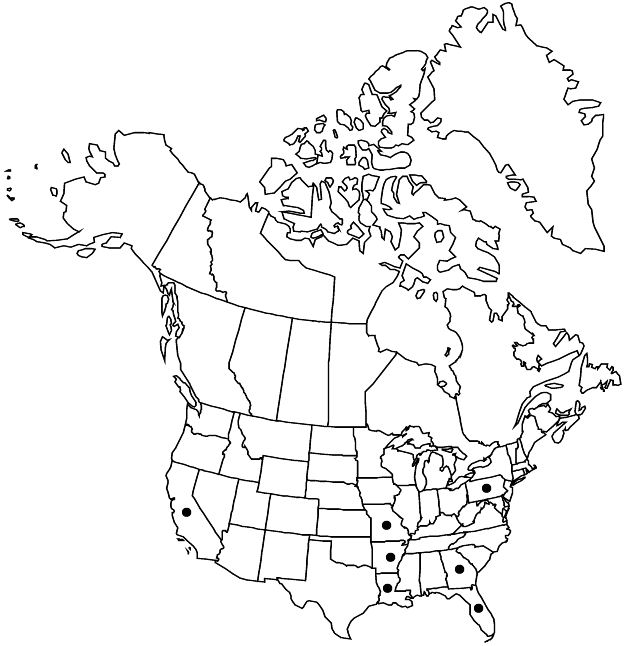Difference between revisions of "Euphorbia ophthalmica"
Syn. Pl. 2: 13. 1806.
FNA>Volume Importer |
FNA>Volume Importer |
||
| Line 33: | Line 33: | ||
|elevation=0–200 m. | |elevation=0–200 m. | ||
|distribution=Ark.;Calif.;Fla.;Ga.;La.;Mo.;Pa.;Mexico;West Indies;Central America;South America;introduced in Europe. | |distribution=Ark.;Calif.;Fla.;Ga.;La.;Mo.;Pa.;Mexico;West Indies;Central America;South America;introduced in Europe. | ||
| − | |discussion=<p><i>Euphorbia ophthalmica</i> is a weedy species distributed throughout the Neotropics. It is also adventive in the Old World. Whether it is indeed native to the southeastern United States is questionable; it is introduced in Arkansas, California, Missouri, and Pennsylvania and likely occurs also in other states. Although sometimes treated as <i>E. hirta</i> <i></i>var.<i> procumbens</i>, <i>E. ophthalmica</i> appears sufficiently distinct to justify recognition at the rank of species, differing primarily by its mostly prostrate growth form, smaller leaves, and strictly terminal clusters of cyathia.</p> | + | |discussion=<p><i>Euphorbia ophthalmica</i> is a weedy species distributed throughout the Neotropics. It is also adventive in the Old World. Whether it is indeed native to the southeastern United States is questionable; it is introduced in Arkansas, California, Missouri, and Pennsylvania and likely occurs also in other states. Although sometimes treated as <i>E. hirta</i> <i></i></i>var.<i><i> procumbens</i>, <i>E. ophthalmica</i> appears sufficiently distinct to justify recognition at the rank of species, differing primarily by its mostly prostrate growth form, smaller leaves, and strictly terminal clusters of cyathia.</p> |
|tables= | |tables= | ||
|references= | |references= | ||
| Line 57: | Line 57: | ||
|publication year=1806 | |publication year=1806 | ||
|special status= | |special status= | ||
| − | |source xml=https://jpend@bitbucket.org/aafc-mbb/fna-data-curation.git/src/ | + | |source xml=https://jpend@bitbucket.org/aafc-mbb/fna-data-curation.git/src/f6b125a955440c0872999024f038d74684f65921/coarse_grained_fna_xml/V12/V12_1108.xml |
|genus=Euphorbia | |genus=Euphorbia | ||
|section=Euphorbia sect. Anisophyllum | |section=Euphorbia sect. Anisophyllum | ||
Revision as of 18:15, 24 September 2019
Herbs, usually annual, rarely short-lived perennial, with slender to slightly thickened taproot. Stems usually prostrate, rarely ascending, 6–22 cm, usually both strigillose and hirsute. Leaves opposite; stipules distinct, subulate-filiform, undivided or divided into 2–4 narrowly triangular to linear-subulate segments, no dark, circular glands at base of stipules, 0.9–1.5 mm, pilose or strigillose; petiole 0.3–1.2 mm, glabrescent, strigillose, or sericeous; blade usually ovate or oblong, rarely subrhombic, 4–13 × 3–7 mm, base asymmetric, one side usually angled and other side rounded, margins coarsely serrulate, apex acute, surfaces often with red spot in center, strigillose or sericeous, or adaxial surface glabrescent; 3-veined from base. Cyathia in dense, terminal, capitate glomerules, with reduced, bractlike leaves subtending cyathia; peduncles 0–0.8 mm. Involucre obconic, 0.5–0.7 × 0.4–0.6 mm, strigillose; glands 4, yellow green to pink, circular to slightly oblong, 0.1–0.2 × 0.1–0.2 mm; appendages absent or white to pink, forming thin rim around edge of gland or oblong, 0.1–0.2 × 0.1–0.3 mm, distal margin entire or shallowly lobed. Staminate flowers 2–8. Pistillate flowers: ovary strigillose, often canescent when young; styles 0.1–0.3 mm, 2-fid 1/2 to nearly entire length. Capsules ovoid, 1–1.2 × 1–1.3 mm, strigillose; columella 0.7–1.1 mm. Seeds orange-brown to pinkish, narrowly ovoid, 4-angled in cross section, 0.7–0.9(–1.1) × 0.5 mm, usually rugulose, with 3–6 faint, low, transverse ridges, rarely almost smooth.
Phenology: Flowering and fruiting year-round.
Habitat: Hammock forests, disturbed areas in lawns, roadsides.
Elevation: 0–200 m.
Distribution

Ark., Calif., Fla., Ga., La., Mo., Pa., Mexico, West Indies, Central America, South America, introduced in Europe.
Discussion
Euphorbia ophthalmica is a weedy species distributed throughout the Neotropics. It is also adventive in the Old World. Whether it is indeed native to the southeastern United States is questionable; it is introduced in Arkansas, California, Missouri, and Pennsylvania and likely occurs also in other states. Although sometimes treated as E. hirta var. procumbens, E. ophthalmica appears sufficiently distinct to justify recognition at the rank of species, differing primarily by its mostly prostrate growth form, smaller leaves, and strictly terminal clusters of cyathia.
Selected References
None.